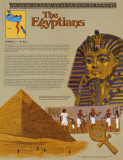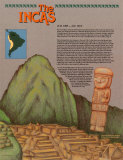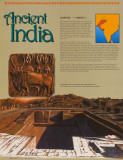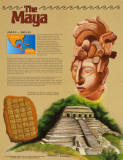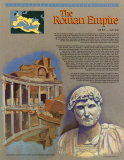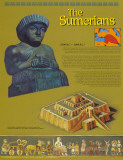|
|
|
|
|
|
|
|
|
|
|
|
SUGGESTED READING
FOR ANCIENT
CIVILIZATIONS
|
|
|
|
|
|
|
|
|
|
|
|
|
|
|
|
|
|
|
 |
|
|
|
Ancient Civilizations History Posters
for social studies educators and home schoolers.
|
history posters > ANCIENT CIVILIZATIONS 1 | 2 < social studies
|
|
Educational history posters from the “Ancient Civilizations” poster series include Ancient China, Egyptians, Greek, Inca, India, Jews, Maya, Ancient Persians, Roman Empire and Ancient Sumarians posters.
• “If civilization has risen from the Stone Age, it can rise again from the Wastepaper Age.” ~ Jacques Barzun
• “The last struggle for our rights, the battle for our civilization, is entirely with ourselves.” William Wells Brown
• “The imaginative child will become the imaginative man or woman most apt to create, to invent, and therefore to foster civilization.” ~ L. Frank Baum
• “Education is the transmission of civilization.” Will Durant
• “Civilization is a disease which is almost invariably fatal.” ~ William R. Inge
• “A civilization is built on what is required of men, not on that which is provided for them.” Antoine de Saint-Exupery
• “Aesthetic matters are fundamental for the harmonious development of both society and the individual.” ~ Friedrich Schiller
• “Civilization is a movement and not a condition, a voyage and not a harbor.” ~ Arnold J. Toynbee
|
|
|
Assyrians –
(1000 B.C. — 700 B.C.)
Assyria emerged from dependency on the Babylonians and Mitanni to become one of the great empires of the ancient Middle East. The Assyrian empire stretched from Egypt to the Persian Gulf and encompassed Mesopotamia. They were builders of monumental structures whose archeological remains can be seen at Ninevah, and noted for their fighting prowess and cruelty. The last great Assyrian king was Ashurbanipal.
|
|
|
|
Ancient China –
(2000 B.C. — A.D. 220)
Like the civilizations of the Fertile Crescent, Chinese civilizations grew up in the valleys surrounding two great rivers — the Yellow River and the Yangtze River. The rich, fertile plain that lies between these two rivers contains about 90 percent of China's land that is usable for farming. And it was here that China's first cities appeared, around 2000 B.C.
Ancient Chinese civilization was in many ways isolated from the rest of the world. This was mostly due to China's unusual geography. To the east lay the Pacific Ocean, north of the river valley was the barren Gobi desert and the 14,000 foot high plateau of Mongolia. To the west was another desert. And to the south was the most forbidding obstacle of all — the Himalaya Mountains. The Chinese believed that China was the center of the world, so they called it the Middle Kingdom. Because China was so isolated, it did not contribute as much to world civilization as other ancient cultures. But the ideas of ancient China's greatest philosopher — a man named Confucius —are still studied today.
There are two important authorities in Chinese civilization — the family and the emperor, or king. Everyone had a special role in the Chinese family. One sign of the importance of the family is that the Chinese were the first people known to use two names: a personal name and a family name. Ancient China was ruled by families called "dynasties." The first dynasty was the Shang dynasty, which ruled from 1500 B.C. to 1027 B.C. This was followed by the Chou (jo) dynasty, which lasted for 800 years! During the next dynasty, the Ch'in, China's famous Great Wall was built. This wall is so large it can be seen from space! The ancient Chinese developed a remarkable writing system, in which each character, or symbol, stood for an idea. A scholar in ancient China had to know between 5,000 and 10,000 of these characters! Most experts say ancient Chinese civilization ended around A.D. 220, when the Han dynasty collapsed. But the dynasty system continued to rule China well into the 20th century.
Artwork depicts seated limestone Buddha from the T'ang dynasty, and the Great Wall.
• China & Chinese Culture posters
• Ancient China (DK Eyewitness Books)
|
|
|
|
The Egyptians
(3100 B.C. — 31 B.C.)
Text from the series poster: The civilization ancient Egypt was one of the most advanced, complex, and fascinating civilizations in world history. It grew up along the mighty Nile River in northeastern Africa, and lasted for more than 3,000 years. It produced some of the greatest rulers of all time, and it left behind some of the most impressive monuments ever built — including the world-famous pyramids the Egyptians constructed as tombs for their leaders.
The civilization of ancient Egypt was almost totally dependent upon the mighty Nile. The river was an important means of transportation between upper and lower Egypt, and its annual flood waters created a rich, black mud that allowed Egyptian farmers to grow many important crops. On either side of the Nilve River were scorching deserts. These deserts could make life harsh, but they also protected Egypt from attacks by invaders. Most experts say Egyptian civilization really began around 3300 B.C., when a king named Menes (MEE-neez) united the civilizations uf upper Egypt and lower Egypt. The kings of Egypt were known as pharaohs. To the Egyptians, the pharaohs were as powerful as gods. The Egyptian language was written in picture symbols called “hieroglyphics”. These hieroglyphics can be found on many of their magnificent temples and pyramids. The pyramids themselves are the oldest and largest stone structure in the world. The body of the head pharaoh was first “mummified,” or preserved, and then placed in a special chamber deep inside the pyramid. Since the Egyptians believed that a pharaoh continued to rule in the afterlife, they wre buried with all their possessions, and with large amounts of gold and jewels. One of the most famous tombs was the tomb of Tutankhamen, whch was discovered in 1922. It was filled with gold and other rare treasures.
Egyptian history is divided into three periods called the Old Kingdom, the Middle Kingdom, and the New Kingdom. In between were times of turmoil the Egyptians called “illnesses.” Egypt reached its peak during the New Kingdom, which began in 1554 B.C., but around 1200 B.C., Egypt's power began to wane. Foreign invaders such as the Assyrians and Persians ruled Egypt for a time, to 332 B.C., Alexander the Great conquered Egypt. But Egyptian civilization did not really end until 31 B.C., when the Roman general Octavia defeated Cleopatra's navy and made Egypt a province of Rome. . . .
Artwork depicts one of the three great pyramids at Giza, the funeral mask of Tutankhamen, a ...... in the shape of an anhk, and a wall painting illustrating tax collection.
• more Egypt and Egyptian culture posters
• Spend the Day in Ancient Egypt: Projects and Activities That Bring the Past to Life
• Nile River Valley Poster Map
|
|
|
|
The Greeks
(2000 B.C. – 323 B.C.)
Ancient Greece was one of the world's greatest civilizations. The Greeks made many important and lasting contributions to humanity – including the idea of democracy and the art of drama. They were also the first people to study medicine, geometry, physics and philosophy. But the ancient Greeks also place a high value on physical fitness. They loved sports and games. The Greeks invented the Olympic Games, which are still popular today.
Greek civilization developed on a rocky peninsula that sticks out into the Mediterranean Sea, and on the many islands surrounding the peninsula. Ancient Greece was not really a single country. It was made up of many smaller, independent communities called city-states. These city-states did not always get along, and many wars were fought between them. Most people in ancient Greece made their living by farming. The Greeks grew crops like wheat, barley, olives, and grapes. Ancient Greek artists produced some of the most beautiful objects ever made. They were especially gifted at making pottery.
The Greeks built marvelous cities, the greatest of which was Athens. The statue shown here depicts Pericles, who ruled Athens during its greatest period. Athens was named for Athena, one of the many gods and goddesses worshipped by the ancient Greeks. Everywhere in Greece, you can find the ruins of wondrous temples built by the ancient Greeks to honor their gods. Ancient Greek civilization reached its peak from 461 B.C. to 323 B.C. During these years, Greek writers, teachers, and artists produced some of their greatest works. In later years, invasions and wars began to destroy Greek civilization. In 146 B. C., Greece officially became a part of the next great civilization – the Roman Empire.
Artwork depicts the bust of Pericles, ruler of Athens, and the Parthenon on the Acropolis.
• Greece & Greek Culture posters
• more Ancient Greek Civilization posters
• History Pockets: Ancient Greece
|
|
|
|
The Incas
(A.D. 1200 — A.D. 1533)
The Inca Indians ruled one of the largest and richest empires in the Western world. The Inca empire at its height stretched for 2,500 miles along the western coast of South America. And it included parts of the present-day countries of Peru, Bolivia, Colombia, Ecuador, Argentina and Chile. The empire was centered around the capital city of Cuzco, located high in the Andes mountains. From there the Inca ruler controlled the lives of his 6 million subjects.
The Inca began their rise to power in the year 1200. At that time, there had already been civilizations in the highlands of Peru for more than 1,000 years. It was from these earlier civilizations that the Incas learned to build fortress walls made from huge blocks of carefully carved stone. The Incas did not use mortar to hold the stones together. Instead, they carved the stones so precisely that they fit perfectly. And many of their walls still stand, despite the many earthquakes that have struck Peru. The Inca were farmers, and they found ways to grow corn and potatoes at elevations of 11,000 feet and higher. They build terraced fields along the steep mountainsides in order to increase the amount of land they could use for growing food. The Inca were also known for their fine cloth and beautiful jewelry. The vast Inca empire was held together by a system of stone highways. Swift runners used these highways to carry messages from the Inca ruler to all parts of the empire. Religion was very important to the Inca. Their most important god was Inti —the sun god. The Inca never developed a system of writing. But special officials kept detailed records with a device called a quipu (key-poo), which was a length of cord with knotted strings of different sizes and colors. Each color or knot stood for a different item.
In 1532, the Spanish explorer Francisco Pizarro arrived in South America. Within months, Pizarro and his army had slaughtered most of the Incas and taken the Inca ruler, Atahualpa, prisoner. And even though he paid a huge ransom of gold and silver, Atahaulpa was killed. The Spanish tried to destroy all traces of the Inca empire. But fortunately many Inca objects and ruins have survived the centuries — including the famous city of Machu Picchu, shown here, which attracts thousnds of tourists every year.
Artwork depicts the ruins of Machu Picchu, and a carved stone figure.
• The Ancient Inca (People of the Ancient World)
|
|
|
|
Ancient India
(2500 B.C. — 1500 B.C.)
When historians talk about India, they usually mean the area that now includes Pakistan and Bangladesh, as well as modern India. It was in this region, just south of the world's tallest, and most rugged moutains, that one of the great civilizations of ancient times flourished. This civilization is known as the Indus Valley civilization, because it grew up along the Indus River in the north. Like the Nile and the Tigris and the Euphrates Rivers, the Indus River flooded its banks every year, creating a rich soil on which farmers could grow crops.
Around the year 2500 B.C., at the same time the Egyptians were building the great pyramids, the first cities rose up in the Indus Valley. The largest of these cities were Harappa and Mohenjo-Daro. Each of these cities had more than 30,000 people. And each was carefully planned, with streets that ran north-south and east-west, like a grid. They were surrounded by impressive walls made of rock-hard mud bricks. Experts have found ruins of a public storage house for grain in both cities, suggesting that the Indus Valley people had some kind of organized government. The people of Harappa and Mohenjo-Daro wre also very concerned with cleanliness. They disposed of the garbage by pushing it through narrow slits cut into the walls of houses, where it fell into special containers lined up outside. Most of the Indus Valley people were farmers. They grew wheat, barley, rice, and cotton to make cloth. Trade was also very important. The Indus people used special clay seals like the one shown here to mark packages of goods.
Around 1500 B.C., this remarkable civilization began to show signs of decline. No one really knows why. Some experts say the Indus River may have changed course, leaving the cities stranded. Others say the Indus Valley people may have overfarmed the soil and been forced to abandon their homes. But the most likely reason is that other peoples invaded from the north and killed off or enslaved the Indus Valley dwellers.
Artwork depicts the ruins of the public bath at Mohenjo-Daro, and one of the many clay seals used by Indus Valley peoples to mark packages.
• National Geographic Investigates: Ancient India: Archaeology Unlocks the Secrets of India's Past
• Hinduism posters
• Buddhism poster
|
|
|
|
Ancient Jews
(2000 B.C. – 922 B.C.)
The ancient Jews did not rule a large and powerful empire like many of the other ancient civilizations. But they made a very important contribution to the world. This contribution is the idea of monotheism – the worship of one God instead of many gods and goddesses. The Jews were the first to believe that one all-powerful god is the creator of all things, and today, nearly all of the world's major religions are monotheistic.
The ancient Jews considered a man named Abraham to be their founder. Abraham lived in Mesopotamia sometime around 2000 B.C. but he left Mesopotamia and went to live in a land called Canaan, which is now known as Palestine. Around 1650 B.C., Canaan was hit by a severe drought and famine. Many Jews went to Egypt to escape. At first, they were treated well, but later, a new Pharaoh, or Egyptian ruler, made the Jews his slaves. Sometime between 1300 and 1200 B.C., the Jews were led to freedom by a man named Moses. According to the Old Testament, Moses went to a mountaintop along the way and spoke to God. He came down with two stone tablets on which were written ten rules, or commandments. These commandments, along with other religious teachings that Moses delivered became the rules of Judaism – the Jewish religion. These rules were written down in a book, called the Torah, shown here.
The Jews thought of themselves as members of 12 tribes, which were founded by the 12 sons of Abraham's grandson Jacob. The tribes decided to unite as one kingdom around 1020 B.C. Their first king was Saul. He was followed by David and Solomon. After Solomon's death, the northern tribes split from the souther tribes. This weakened the Jews, who were invaded and conqured many times – first by the Assyrians around 900 B.C., then by the Babylonians, the Persians and finally the Romans. These invasions scattered the Jewish people throughout the world.
Artwork depicts the ruins of the ancient fortress at Masada and a rabbi holding the Torah.
• more Judaism posters
• Ancient Israelites and Their Neighbors: An Activity Guide
|
|
|
|
The Maya
(500 B.C. – 900 A.D.)
The Maya Indians built one of the world's most remarkable civilizations in the jungles of Central America. Like the ancient Greeks, who civilization was nearing its peak just as the Maya appeared, the Maya are known for their fabulous temples, and for their amazing knowledge of math and science. The Maya were the only Indians in America to develop a written language. Today, people come from all over the world to view the crumbling ruins of their once-great cities.
The Maya lived throughout Central America's Yucatan Peninsula in what are now the nations of Mexico, Guatemala, and Belize. They were a short, stocky people, with dark skin and black hair. They greatly admired sloping foreheads, and would frequently strap boards to babies' heads in order to flatten them. Maya life centered around the great cities, which were used for festivals, markets, and religious ceremonies. Strangely enough, almost no one lived in the cities. Only priests were allowed to live there for short periods of time. All other people lived in smaller communities around the cities, or on farms scattered throughout the countryside. The Maya grew crops such as corn, beans, squash, and tomatoes. They liked to dance, and they played a difficult game in which players had to hit a ball through a stone ring with their knees or hips.
Like the Greeks, the Maya worshipped many gods. They had rain gods, a sun god, a corn god, and gods of death and the underworld. The Maya were very interested in measuring and studying time. They invented a highly accurate calendar, which they used to help them track the movements of the sun, stars, and planets. Maya civilization began to decline around 800, as the Maya abandoned their cities one by one. Even today, no one really knows why this remarkable civilization suddenly ended.
Artwork depicts the Temple of the Inscriptions at Palenque, statue of the Maya leader Lord Pacal, and the Mayan calendar.
• more Maya posters
• Honduras posters
• Your Travel Guide to Ancient Mayan Civilization
|
|
|
|
The Roman Empire
(29 B.C. – A.D. 476)
The story of the Roman Empire is one of the most remarkable stories in world history. Roman civilization began with a small group of shepherds who lived in central Italy. But at its peak, the Roman Empire covered half of Europe, most of the Middle East, and the northern coast of Africa. The people who lived in this vast Empire spoke many different languages and had different sets of customs and religious beliefs. But they were united under one system of laws and government. Even today, scholars consider this to be one of the greatest achievements of any civilization.
Although ancient Roman civilizations can be traced back to about 1000 B.C., the Roman Empire really began in 29 B.C. That year, Octavian – a Roman general and the adopted son of Julius Caesar – became the unchallenged leader of the entire Roman world. He gave himself the name Augustus, which means “exalted.” Augustus was perhaps Rome's greatest ruler, and he set up a central government and a system of laws that brought 200 years of peace to the Empire. Life in the Roman Empire during this time was very pleasant – if you were one of the wealthy or the powerful. These people lived in large, beautifully decorated homes filled with art objects gathered from all parts of the Empire. But very few Romans belonged to this wealthy class. Most were farmers, city workers, or soldiers. And a large number were slaves captured by Roman soldiers when they conquered new territories. Most Romans wore a simple style of clothing called a “tunic.” A large sheet called a “toga” was draped over the top of this. Like the Greeks, the Romans worshipped many gods. But around A.D. 30, Christianity began to spread throughout the Empire. The Romans were famous for their cities, which were carefully planned. They built a remarkable sytem of roads, and they constructed “aqueducts” for carrying water to all parts of the city.
Eventually the Empire grew too large to be effectively controlled from Rome. Around the year 283 the Empire was divided into an eastern half and a western half – each ruled by a separate emperor. This change became permanent in 395. But fighting among Roman leaders and attacks from outside tribes caused the fall of the Empire in 476. The Eastern Roman Empire became the Byzantine Empire, which survived until 1453.
Artwork depicts a Roman lake theatre at Tivoli, and a bust of the Roman Emperor Hadrian.
• The Fall of the Roman Empire: A New History of Rome and the Barbarians
|
|
|
|
The Persians
(550 B.C. — 331 B.C.)
At its peak, the Persian Empire was one of the largest in history. The Persians controlled an area roughly the size of the present day United States. The empire they created lasted a little more than 200 years. But in that short time, they made many important contributions to world civilization. The ruins of some of their great cities can still be seen today in the nation of Iran, whch was once called "Persia."
The Persians began their rise to power around 550 B.C., under the leadership of a king named Cyrus. The Persian army was very strong, and soon conquered all of the lands from northwest India to Egypt. But unlike many other conquerors, Cyrus was not cruel. His army did not kill or torture the people of other cities. Instead, Cyrus believed that it was better to let people continue to follow their religious beliefs and ways of life. His reputation for kindness was so great that the kingdom of Babylon allowed him to march in and take over without a fight! The Persians were originally a nomadic people — that is, one that moved from place to place. But they also adopted many of the ways of life of the peoples they conqurerd. The Persians believed strongly in honor and considered it a disgrace to lie or to be in debt. They worshipped many gods, but they did not build temples, they prayed on mountaintops instead. Many of the early Persians were farmers, and they developed an amazing system of irrigation that involved underground tunnels up to 100 miles long.
Under a leader named Darius, the Persian Empire grew and flourished. The Empire was held together by a system of excellent roads and by the use of a single kind of money. In 480 B.C., a Persian ruler named Xerxes invaded Greece. But the Greeks defeated the Persians and drove them out of Europe. This was the beginning of the end of the Persian Empire. In 331 B.C. the Empire was conquered by Alexander the Great.
Artwork depicts the ruins of the Persian capital Persepolis, a sculpture in the shape of a human head from the columns at Apadana, and a decorative silver chalice.
• The Persian Empire (Library Binding)
• Middle East posters
|
|
|
|
Ancient Sumerians —
(3500 B.C. — 2000 B.C.)
Most experts agree that the Sumerians built the world's first civilization. The Sumerians lived in a region of the world known as Mesopotamia, or the Fertile Cresent. This area runs along two rivers, called the Tigris and the Euphrates, and along the eastern coast of the Mediterranean Sea. it is now a part of the nations of Iraq, Syria, Lebanon, Jordan, and Israel.
There are several reason the Sumerians are considered to be the first “civilized” people. For example, they were the first to build large, permanent cities. Some of their cities had over 10,000 people. The Sumerians were also the first people to have specialized jobs. This means that some people in Sumer were farmers, while others held jobs such as teachers, pottery-makers, and “scribes,” or writers. In fact, the Sumerians were the first people to develop their own written language. Sumerian writing is called cuneiform. Cuneiform is made up of symbols that have various meanings. Some of the symbols stand for objects, and others stand for sounds or ideas. The Sumerians also invented the wheel, the plow, and the sailboat — three devices that changed the world forever.
The first Sumerian cities were little more than clusters of huts sitting on a flat, open plain. This made it easy for other peoples to attack the cities and steal livestock and grain. So the Sumerians gradually began to build larger cities, and surround them with high walls of mud brick. In the center of each city was a three level pyramid structure called a “ziggurat”. Like many early civilizations, the Sumerian believed in many gods. For this reason, their cities were ruled by both priests and kings. Over the years, the great cities of Sumeria fought many wars with one another. This fighting eventually destroyed Sumeria, and cleared the way for later civilizations.
Artwork in poster depicts a Sumerian ziggurat, a decorative panel from a wooden box found at Ur, and a statue of the Sumerian king Gudea.
• History Begins at Sumer: Thirty-Nine Firsts in Recorded History
|
|
|
previous page | top | ANCIENT CIVILIZATIONS 1 | 2
|
|
I have searched the web for visual, text, and manipulative curriculum support materials - teaching posters, art prints, maps, charts, calendars, books and educational toys featuring famous people, places and events - to help teachers optimize their valuable time and budget.
Browsing the subject areas at NetPosterWorks.com is a learning experience where educators can plan context rich environments while comparing prices, special discounts, framing options and shipping from educational resources.
Thank you for starting your search for inspirational, motivational, and educational posters and learning materials at NetPosterWorks.com. If you need help please contact us.
|
|
|















